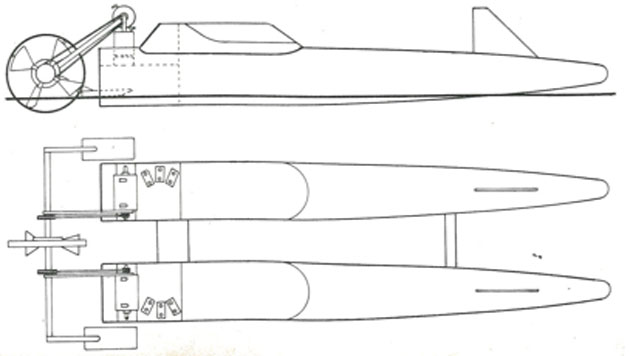MBY racing correspondent Ray Bulman recalls how a hoax involving a steam-powered raceboat made it onto the pages of our esteemed magazine
A few weeks ago, editor Hugo called me to discuss a strange steam-powered raceboat he’d read about in the September 1973 edition of Motor Boat & Yachting. A reader had found the issue lurking in his garage and sent it in to jog our memories.
The boat in question was a lightweight offshore racing catamaran called Hero powered by a modern take on a steam-driven paddle wheel, heavily modified to maximise speed and efficiency.
It was designed and built by a pair of secretive South African brothers who turned up unannounced at that year’s Cowes-Torquay-Cowes powerboat race.
After being refused entry due to the lack of a suitable class in which to compete, the notoriously anti-establishment brothers decided to complete the course anyway and promptly blitzed the entire fleet, finishing 21 minutes ahead of the ‘official’ winner Unowot at an average speed of 78mph.
Hugo was intrigued by this extraordinary tale of a quirky foreign underdog making fools of the racing elite but couldn’t fathom why he was unable to track down a photograph of such a distinctive looking craft.
As one of the few MBY contributors still writing from that era, it fell to me to break the news – no photos existed because the whole steam-powered raceboat story was an elaborate hoax.
Plotting the prank
In those days MBY was published every two weeks and it was easy for a contributor to fake a credible story without the busy sub editors spotting the red herring.
The writer of this piece was the late John Teale, a professional naval architect and world-class practical joker with a regular MBY column.
By the mid-1960s he had already designed a couple of genuine offshore raceboats. He was also a brilliant technician and his story was littered with fine detail and illustrations of the catamaran hull and the steam-engine’s complex engineering.
 He chose South African brothers, the Van der Merwes, as his fictional designer/crew of the steam-powered raceboat partly because John had genuine clients from there and partly because in those days it was harder to fact check stories from over the horizon.
He chose South African brothers, the Van der Merwes, as his fictional designer/crew of the steam-powered raceboat partly because John had genuine clients from there and partly because in those days it was harder to fact check stories from over the horizon.
At the time, I was responsible for all aspects of powerboat coverage in the mag but when I read John’s story I, like many others, fell for it. I should have known better but as with all the best hoaxes it had its roots in reality.
This wasn’t the first time a fast steam-powered racer had been mooted. One had been rumoured to be entering the Round Britain race in 1969 and again in 1984. Neither actually appeared but they provided fertile growing ground for John’s imaginary craft.
 I have always been a keen enthusiast of steamboats, so when I read that one called Hero had taken part in the 1973 Cowes race, I wanted to believe it.
I have always been a keen enthusiast of steamboats, so when I read that one called Hero had taken part in the 1973 Cowes race, I wanted to believe it.
After all, John was a serious naval architect and had included several convincing technical drawings in his story.
The hull design and balsawood building material also made sense.
This was only a couple of years after James Beard and Clive Curtis had built the first successful Cougar offshore catamaran and balsa wood wasn’t so very different from the plywood most racing boats of the era were still built from.
Rumour spreads fast
Readers with similar steamboat leanings to mine wanted the story to be true and even those attending the race began putting two and two together and coming up with five.
Was that distant wash the only visible sign of the low-slung steam racer? And could that thick black smoke be from a steamboat’s boiler rather than a crude turbodiesel?
Readers began asking where this amazing craft could be seen and how to contact the mysterious South African owners. Not wanting to give the truth away, we bluffed our way out of it by announcing that Hero had been declared a national secret because of its strong military potential.
As far as I recall we never did reveal the truth but eventually the story of the boat which beat them all slid away, only for it to reappear exactly 42 years later thanks to a nostalgic MBY reader. Thank you Peter Stewart for bringing it to our attention again.
To download the original 1973 article, click here (0.8MB PDF).










